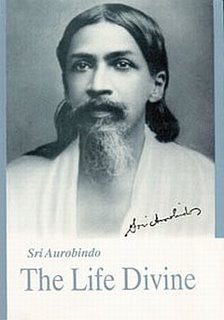 |
The Problem of Life
The Perfect and Integral Harmony
The human being is ordinarily a bundle of disharmonies and contradictions at various levels and between different planes of consciousness. Any attempt at perfection is usually lop-sided for we are habituated to work on one plane of consciousness at the cost of the other planes. Thus a great intellectual development of the mind can be at the expense of neglecting the body that would result in an illness or a cultivation of ascetic purity may leave the emotions starved to rebel one day. At best, we achieve a ‘workable compromise’ (The Life Divine, pg.230) between the different parts of the being around an ego which itself is skewed in functioning. But, ‘the Deity within will not be satisfied eventually with less than a perfect harmony combining in itself the integral development of our many-sided personalities’. (Ibid)
|
|
It is impossible to effectuate a perfect harmony at the surface personality. One has to seek the principle and power of perfection beyond one’s outer being. Sri Aurobindo denotes two sources:
(a) Deep down, in the subconscient, ‘wrapped up’ in the veil of ‘lower Maya’ (Ibid), and
(b) High up, in the Superconscient, not veiled but in eternal bloom though ‘separated from us by the by the veil of our self-ignorance’.(Ibid)
In the subconscient, things move mechanically forging an unconscious harmony. The electrons know that they have to rotate in their orbits, the hydrogen molecule always combines with oxygen in a pre-determined harmony to produce water and the ant knows how to build an ant-hill. Thus, there is a ‘mute premonition’(Ibid) that works out a limited harmony within fixed circles but that falls short of the ideal of perfect integration sought by the Deity within the human being. Therefore it is in the superconscient ‘that we must seek for the reconciling power and knowledge’ (Ibid) in the broadest possible terms.
Integral Harmony
The human being seeks an integral harmony that can only ‘come to him from above’, from a superior poise of consciousness. It needs two conditions:
(a) A point of support in the individual that is not the ego but a fourth dimensional soul-principle, and
(b) An universalisation of the individual being.
‘For only by developing a mind which shall have knowledge of the mind of others as of itself, free from our mutual ignorance and misunderstanding, a will that feels and makes itself one with the will of others, an emotional heart that contains the emotions of others as its own, a life-force that senses the energies of others and accepts them for its own and seeks to fulfil them as its own, and a body that is not a wall of imprisonment and defence against the world , but all this under the law of a Light and Truth that shall transcend the aberrations and errors, the much sin and falsehood of our and others’ minds , wills, emotions, life-energies, -- only so can the life of man spiritually and practically become one with that of his fellow-beings and the individual recover his own individual self’. This aspiration needs to be fulfilled not by plunging into the subconscient below but by evolving to the Godhead above ‘seated in the sea of eternal Light’.(Ibid, pg.231)
The principle and power of perfection has its origin in the Supreme creative consciousness –the Supramental Consciousness. One has to begin the ascent to the top through ‘love, mental illumination and the vital urge to possession and self-giving’ (Ibid), but one has to transcend them to achieve ‘the supramental realisation of conscious unity with the One and with all in our being and in all its members’ (Ibid) so that humanity can have its salvation and its perfect integral harmony.
Thus,
While the first status of Life is to be aware of the inner being behind the surface personality,
The second status is to achieve the universal or cosmic consciousness,
The third status is to achieve a harmony within oneself, between the different parts and between the soul-principle and its projections,
The fourth status of Life is the ascent towards the supramental unity.
Date of Update:
22-Jan-19
- By Dr. Soumitra Basu
|

